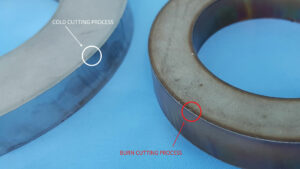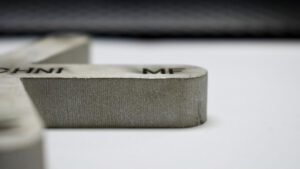Sheet metal cutting, an intricate process that shapes the backbone of numerous industries, stands as a testament to human ingenuity in manufacturing. This article delves deep into the world of sheet metal cutting, exploring its history, techniques, and the impact it has on various sectors.
What is Sheet Metal Cutting?
Sheet metal cutting, a fundamental process in the metalworking industry, involves the precise removal of material from sheet metal stock to form a specific part or component. This process, essential in shaping the metal sheet into a finished part, employs various tools and techniques, ensuring accuracy and efficiency.
The essence of sheet metal cutting lies in its ability to transform a flat metal sheet into various shapes and sizes, tailored to specific needs.
Whether you’re working with thin aluminum or robust steel, understanding the intricacies of cutting sheet metal is crucial.
From using sharp tools like tin snips for simple cuts to more advanced methods like laser cutting, the process varies significantly based on the desired profile and sheet thickness.
At its core, sheet metal cutting is about precision and control. As you delve into this process, you’ll encounter various methods, each with its unique application and benefits. Whether it’s creating straight lines, curved cuts, or intricate patterns, the art of cutting sheet metal is about turning a raw, flat metal object into a functional, aesthetically pleasing piece.
Short History of Sheet Metal Cutting
The journey of sheet metal cutting dates back centuries, evolving from simple hand tools to sophisticated machinery. Initially, craftsmen used basic tools like chisels and hammers to shape metal sheets, a process that required immense skill and effort.
As industries evolved, so did the techniques for cutting sheet metal. The industrial revolution brought about significant advancements, introducing power tools and machines that could handle larger pieces of metal with greater precision.
The introduction of the shearing process, where an upper blade and a lower blade precisely cut the metal, marked a turning point in the efficiency and capabilities of metalworking.
The 20th century saw further innovations, with processes like plasma cutting and laser cutting revolutionizing how metal was cut. These methods offered increased speed, precision, and the ability to cut through thicker materials. The development of CNC (Computer Numerical Control) technology further transformed sheet metal cutting, allowing for highly precise and automated operations.
As you explore the history of sheet metal cutting, it becomes evident that each advancement was driven by the need for greater precision, efficiency, and versatility in handling various metals and thicknesses.
The evolution from manual to automated processes mirrors the progress of technology and industry, showcasing human ingenuity in manufacturing.
How Does the Sheet Metal Cutting Process Work?
Understanding how the sheet metal cutting process works is crucial, especially if you’re involved in fabrication or metalworking. The process begins with selecting the appropriate sheet metal material and determining the required shape and size for the end product.
Once the metal sheet is prepared, the cutting process commences. Depending on the project’s requirements, different cutting methods are employed. The most common techniques include shearing, laser cutting, water jet cutting, and plasma cutting. Each method has its unique mechanism, but they all share the goal of removing excess material from the metal sheet to achieve the desired shape.
A key aspect of the sheet metal cutting process is the consideration of several factors like sheet thickness, cutting speed, and the type of metal being cut.
These factors determine the choice of cutting method and the settings of the cutting tool or machine.
For example, thicker sheets might require more powerful cutting methods like plasma cutting, while thinner sheets can be effectively cut using tin snips or a circular saw.
Throughout the cutting process, precision and accuracy are paramount. This is achieved through careful planning, proper tool selection, and skilled execution.
Whether you’re cutting straight lines, forming curved shapes, or creating complex patterns, the success of the sheet metal cutting process lies in the meticulous attention to detail and the understanding of the material and tools involved.
What Are the Various Sheet Metal Cutting Processes?
Sheet metal cutting, a critical process in the fabrication industry, involves several methods, each tailored to different needs and material types. The choice of method significantly influences the quality, efficiency, and cost-effectiveness of the final product. As you explore this field, understanding the different sheet metal cutting operations becomes vital, whether you are working on a small DIY project or a large industrial task.
Shearing
Shearing is a widely used technique in sheet metal cutting, known for its simplicity and efficiency. This process involves two sharp blades, typically made of high-grade tool steel, positioned one above the other. The upper blade descends to cut the metal sheet placed below, shearing it with precision and minimal waste.
- Applications of Shearing in Sheet Metal Cutting:
- Ideal for making straight-line cuts on flat sheet metal.
- Commonly used in mass production due to its speed and efficiency.
- Suitable for cutting metal sheets of varying thicknesses, though typically used for thinner materials.
- Often employed in preliminary shaping of metal before it undergoes further processing.
Laser Cutting
Laser cutting stands out for its precision and versatility. This method uses a high-powered laser focused onto the sheet metal, melting, burning, or vaporizing the material along the desired cut line. Laser cutting machines are typically controlled by CNC systems, allowing for intricate patterns and shapes.
- Applications of Laser Cutting in Sheet Metal Cutting:
- Produces highly accurate and clean cuts, perfect for detailed designs.
- Capable of cutting through various metal types and thicknesses, including steel, aluminum, and titanium.
- Frequently used in industries requiring high precision, such as aerospace and automotive manufacturing.
- Offers flexibility in cutting complex shapes and small, intricate parts.
What Are the Different Types of Laser Cutters Used for Sheet Metal Cutting?
Laser cutters vary in type, primarily based on the laser source they use. Each type has its distinct advantages and applications.
Fiber Laser Cutters
Fiber laser cutters use a solid-state laser made from a ‘seed’ laser and amplified through special fibers. This technology is known for its energy efficiency, cutting speed, and quality.
- Key Features of Fiber Laser Cutters:
- Exceptional precision, ideal for detailed and intricate cuts.
- High cutting speed, significantly faster than traditional CO2 lasers.
- Energy-efficient, reducing operational costs.
- Versatile in cutting reflective metals like aluminum and copper without back reflections.
CO2 Laser Cutters
CO2 laser cutters, using a gas laser, are among the most common types of laser cutters in the industry. They are versatile and capable of cutting a wide range of materials.
- Key Features of CO2 Laser Cutters:
- Suitable for cutting thicker metal sheets.
- Offers a smooth finish, especially on thicker materials.
- Versatile in handling various materials beyond metals, including plastics and wood.
- Generally more cost-effective in terms of initial investment compared to fiber lasers.
Water Jet Cutting
Water jet cutting is a versatile and powerful sheet metal cutting operation that uses a high-pressure stream of water, often mixed with abrasive materials, to cut through metal. This technique is known for its precision and ability to cut a wide range of materials.
- Applications of Water Jet Cutting in Sheet Metal Cutting:
- Ideal for materials sensitive to high temperatures, as it doesn’t generate heat.
- Capable of cutting complex shapes with high precision.
- Suitable for a variety of materials, including metals, glass, and composites.
- Often used for projects requiring minimal material distortion and no heat-affected zone.
Plasma Cutting
Plasma cutting is a process that employs a plasma torch to cut through electrically conductive materials like steel, stainless steel, and aluminum. This method is favored for its speed and ability to cut thick materials.
- Applications of Plasma Cutting in Sheet Metal Cutting:
- Efficient for cutting thick metal sheets and plates.
- Used extensively in heavy fabrication, automotive, and industrial applications.
- Capable of producing relatively clean cuts with a small heat-affected zone.
- Ideal for large-scale projects where speed is a critical factor.
Punching
Punching, a common sheet metal cutting operation, involves the use of a punch and die to create holes or cut out shapes from the metal sheet. Punching operation is highly efficient for creating repetitive patterns or shapes.
- Applications of Punching in Sheet Metal Cutting:
- Commonly used for creating holes, slots, or shapes in metal sheets.
- Essential in mass production for consistent and rapid production of parts.
- Often combined with other processes like bending or forming.
- Suitable for a range of materials, with varying thicknesses.
Blanking
Blanking is a sheet metal cutting process where a punch and die are used to cut out a piece from the main sheet, known as a blank. This method is known for its precision and repeatability.
- Applications of Blanking in Sheet Metal Cutting:
- Ideal for producing flat, uniform parts in large quantities.
- Frequently used in the automotive and appliance industries.
- Allows for tight tolerances and clean edges.
- Efficient for processing a variety of metal types and thicknesses.
Deburring
Deburring is a finishing process used after cutting sheet metal to remove sharp edges or burrs. This operation ensures the safety and quality of the sheet metal parts.
- Applications of Deburring in Sheet Metal Cutting:
- Essential for improving the safety and handling of metal parts.
- Used across various industries to ensure parts fit correctly and function as intended.
- Can be performed manually or using specialized machinery.
- Important for preparing parts for further processes like painting or assembly.
Trimming
Trimming involves cutting the edges or excess material from a metal part to achieve the desired shape or size. It’s an important finishing process in sheet metal fabrication.
- Applications of Trimming in Sheet Metal Cutting:
- Frequently used in the automotive industry for shaping body panels and components.
- Essential for achieving precise dimensions and fit for assembled parts.
- Can be performed using specialized trimming machines or manually.
- Important for ensuring the aesthetic quality and functionality of the final product.
What is the Easiest Technique to Cut Sheet Metal?
For beginners or those seeking a straightforward approach, hand shears or tin snips are the easiest tools for cutting sheet metal. They require minimal setup, are cost-effective, and are perfect for cutting thin sheets along straight lines or slight curves.
Which Tools are Commonly Used for Sheet Metal Cutting?
Sheet metal cutting, a crucial process in various industries, involves an array of tools, each designed for specific tasks. The right tool not only ensures efficiency but also enhances the precision of the cut. Below is a list of commonly used tools in sheet metal cutting:
- Shears (Hand Shears and Power Shears):
- Hand Shears: Ideal for smaller projects and precise cuts.
- Power Shears: Used for larger projects, providing speed and power for thicker sheets.
- Nibblers:
- Perfect for cutting complex shapes and contours.
- Can be used on a variety of thicknesses and materials.
- Chisels and Hammers:
- Traditional tools for basic cutting and shaping.
- Require skill and are mostly used for artistic or small-scale projects.
- Guillotine Cutters:
- Excellent for making straight, clean cuts.
- Utilized in industrial settings for high-volume, repetitive tasks.
- Snips (Tin Snips and Aviation Snips):
- Tin Snips: Ideal for straight cuts and slight curves in thinner metal sheets.
- Aviation Snips: Designed for more intricate cuts and better handling.
- Angle Grinders:
- Versatile for cutting, grinding, and polishing.
- Suitable for thicker and harder metals.
- Scroll Saws:
- Excellent for intricate designs and detailed work.
- Offers precision in cutting patterns and shapes.
- Electric Metal Saws:
- Used for heavy-duty cutting operations.
- Provides clean and efficient cuts in thick metal sheets.
What are the Main Parameters in the Sheet Metal Cutting Process?
In the intricate process of sheet metal cutting, several key parameters play crucial roles in determining the quality, efficiency, and feasibility of the operation. Understanding these parameters is essential for achieving optimal results in your metalworking projects.
- Material Thickness:
- Dictates the amount of force or energy required for cutting.
- Influences the choice of cutting method and tooling.
- Thicker materials often necessitate more robust cutting techniques like plasma or laser cutting.
- Cutting Speed:
- Refers to the rate at which the cutting tool or laser moves across the material.
- A critical factor affecting both productivity and cut quality.
- Optimal speed varies depending on the material type and thickness.
- Power Output (for Laser/Plasma Cutting):
- The power setting of the machine, crucial for effectively cutting through different material thicknesses and types.
- Higher power output is typically required for thicker, harder materials.
- Kerf Width:
- The width of the cut or the amount of material removed during the cutting process.
- Kerf affects the final dimensions of the sheet metal part and overall precision.
- Narrower kerfs lead to more material conservation and less waste.
- Cutting Tolerances:
- Refers to the allowable deviation in the cut dimensions, which is crucial for precision manufacturing.
- Tighter tolerances are often required in high-precision industries.
- Surface Finish:
- The quality of the surface post-cutting, which can vary based on the cutting method.
- A smoother finish is often desirable for aesthetic and functional purposes.
Which Are Some of The Most Popular Metals Used for Sheet Metal Cutting?
Sheet metal cutting is utilized across a wide range of metals, each offering unique properties and challenges. Here’s a look at some of the most popular metals used in this process, along with their common applications:
- Steel (Mild and Carbon Steel):
- Widely used due to its strength and affordability.
- Common in automotive parts, construction materials, and appliances.
- Stainless Steel:
- Known for its corrosion resistance and durability.
- Used in medical devices, kitchen equipment, and architecture.
- Aluminum:
- Lightweight and corrosion-resistant.
- Ideal for aerospace, automotive, and consumer goods.
- Brass:
- Combines workability with a visually appealing finish.
- Often used in decorative elements, plumbing fixtures, and musical instruments.
- Copper:
- High conductivity and malleability.
- Common in electrical components and roofing materials.
- Galvanized Steel:
- Steel coated with a layer of zinc to prevent rusting.
- Utilized in outdoor structures, ductwork, and fencing.
- Titanium:
- Exceptional strength-to-weight ratio and corrosion resistance.
- Used in aerospace, medical implants, and high-performance automotive parts.
- Nickel Alloys:
- High resistance to heat and corrosion.
- Used in chemical processing equipment and high-temperature applications.
- Silver, Gold, Platinum:
- Precious metals with specific applications in jewelry and electronics.
- Often used for their conductive and aesthetic properties.
- Zinc:
- Good corrosion resistance and low melting point.
- Commonly used in die-casting and protective coatings.
- Tin:
- Soft, malleable, and corrosion-resistant.
- Used in coatings, soldering, and alloys.
- Lead:
- Dense and malleable.
- Used in radiation shielding and batteries.
- Inconel:
- A nickel-chromium alloy known for its ability to withstand extreme temperatures.
- Used in jet engines, nuclear reactors, and chemical processing.
What Industries Commonly Utilize Sheet Metal Cutting?
Sheet metal cutting is an indispensable process across various industries, each leveraging this technique for specific applications. Below are ten industries that commonly utilize sheet metal cutting, along with how they use it:
- Automotive Industry: Uses sheet metal cutting to create body panels, frames, and engine components.
- Aerospace Industry: Relies on precision sheet metal cutting for airframe structures, engine parts, and interior cabin components.
- Construction Industry: Employs sheet metal for roofing, siding, HVAC systems, and structural elements.
- Industrial Machinery and Equipment Manufacturing: Utilizes sheet metal components in the fabrication of machinery and heavy equipment.
- Electronics Industry: Requires precision-cut metal for enclosures, chassis, and various hardware components.
- Energy Sector, Including Renewable Energy: Uses cut metal sheets for fabricating parts in power generation equipment, including wind turbines and solar panels.
- Shipbuilding Industry: Depends on large-scale sheet metal cutting for hulls, decks, and other structural components of ships.
- Medical Equipment Manufacturing: Needs precisely cut sheet metal for surgical instruments, equipment casings, and hospital furniture.
- Consumer Goods and Appliances: Sheet metal cutting is used for the outer casing and internal components of appliances.
- Railway Industry: Utilizes sheet metal cutting for fabricating train bodies, components, and infrastructure elements.
- Defense and Military Sector: Relies on sheet metal cutting for vehicle armor, weapon components, and infrastructure.
- Metalworking and Fabrication Shops: Use various cutting techniques for custom metal parts and products for a wide range of applications.
- HVAC (Heating, Ventilation, and Air Conditioning): Sheet metal is cut for ductwork, vents, and other HVAC system components.
- Signage and Advertising Industry: Employs sheet metal cutting for creating durable and versatile signs and displays.
- Art and Sculpture: Artists use sheet metal cutting to create intricate designs and sculptures.
Is Sheet Metal Cutting Expensive?
The cost of sheet metal cutting can vary significantly based on several factors. Understanding these factors is essential for estimating the overall expense of your project.
- Complexity of the Design: More intricate designs require advanced cutting techniques, which can increase costs.
- Type of Metal: Different metals, such as stainless steel or titanium, have varying prices and cutting requirements.
- Thickness of the Metal: Thicker materials often require more powerful cutting tools, leading to higher costs.
- Cutting Method Used: Techniques like laser cutting or water jet cutting might have different operational costs compared to traditional methods.
- Volume of Production: Higher quantities can lower the per-unit cost due to economies of scale.
- Level of Precision Required: Projects demanding high precision may involve additional processes, impacting the cost.
- Machine and Tool Wear: Frequent replacement or maintenance of cutting tools can add to the expenses.
What are Some Design Tips for Sheet Metal Cutting?
Designing for sheet metal cutting requires a blend of technical knowledge and creativity. Here are some practical tips to optimize your designs:
- Minimize Complex Cuts:
- Simplify designs to reduce cutting time and costs.
- Example: Opt for straight lines or standard shapes where possible.
- Consider Material Properties:
- Choose a metal that best suits the design requirements and cutting method.
- Example: Use aluminum for designs requiring lightweight and malleability.
- Optimize for Nesting:
- Arrange parts to maximize material usage and minimize waste.
- Example: Align similar parts close together on the metal sheet.
- Allow for Kerf and Material Deformation:
- Adjust designs to account for the width of the cut (kerf) and potential material distortion.
- Example: Increase hole sizes slightly to compensate for the kerf width.
- Design for Bending and Joining:
- If the part requires bending or welding, include appropriate allowances in the design.
- Example: Include bend allowances to ensure accurate final dimensions.
- Incorporate Tolerances:
- Design with realistic tolerances to ensure parts fit together as intended.
- Example: Specify tolerances clearly in design documents to guide the cutting process.
- Avoid Sharp Corners:
- Round off corners to reduce stress concentrations and potential material cracking.
- Example: Use fillets or radiuses on corners instead of sharp angles.
Safety Tips for Sheet Metal Cutting
When working with sheet metal cutting, safety is paramount. Here are essential safety tips to adhere to:
- Wear Protective Gear: Always wear safety goggles, gloves, and hearing protection to guard against flying debris and loud noise.
- Ensure Proper Ventilation: Work in a well-ventilated area, especially when using methods that produce fumes or smoke.
- Use Sharp Tools: Regularly maintain and sharpen cutting tools to reduce the effort needed and prevent accidents.
- Secure the Sheet Metal: Clamp down the sheet metal to prevent movement during cutting, reducing the risk of injury.
- Be Cautious with Power Tools: Handle power tools like electric saws and grinders with care, ensuring they are turned off when not in use.
- Follow Equipment Guidelines: Always operate machinery according to the manufacturer’s guidelines and safety instructions.
- Keep a First Aid Kit Nearby
Common Problems and Defects with Sheet Metal Cutting
Sheet metal cutting can encounter various problems and defects, which can affect the quality of the finished product. Understanding these issues and knowing how to address them is crucial.
Common Defects and Their Fixes:
- Burred Edges:
- Caused by dull cutting tools or improper tool alignment.
- Fix: Sharpen tools regularly and ensure proper alignment.
- Distortion or Warping:
- Occurs due to excessive heat during cutting.
- Fix: Use proper cutting speed and cooling methods to minimize heat buildup.
- Incomplete Cuts:
- Result from inadequate cutting force or blunt tools.
- Fix: Adjust the force or power settings and use sharp tools.
- Rough Surface Finish:
- Caused by using inappropriate cutting methods or tools.
- Fix: Choose the right cutting method and tool for the material and desired finish.
- Material Waste:
- Results from inefficient layout or cutting patterns.
- Fix: Optimize material usage with better nesting and planning.
- Inaccurate Dimensions:
- Due to incorrect tool setup or material movement during cutting.
- Fix: Ensure accurate tool setup and secure the material firmly.
- Excessive Noise:
- Generated by certain cutting processes or equipment.
- Fix: Maintain equipment properly and use sound-dampening methods.
Conclusion
Sheet metal cutting is an intricate and vital process in numerous industries.
Its success hinges on understanding and leveraging various cutting techniques, considering factors like material properties, safety, design intricacies, and cost.
From utilizing the right tools and methods to ensuring safety and addressing common defects, the expertise in sheet metal cutting shapes the efficiency and quality of the final product.
FAQs
Can you cut sheet metal with shears?
Yes, you can cut sheet metal with shears, particularly for thinner sheets. Shears, including hand shears and power shears, are ideal for making straight or slightly curved cuts. They offer a simple, cost-effective solution for smaller or less complex projects.
Can you cut sheet metal with bolt cutters?
While bolt cutters are primarily designed for cutting bolts and wire, they can be used to cut thin sheet metal. However, they might not provide the precision or clean edges desired for finer metalworking projects. They are more suitable for rough cuts or in situations where precision is not a priority.
Can you cut sheet metal with a multitool?
Yes, a multitool can be used to cut sheet metal, especially when equipped with the appropriate cutting attachment. It’s a versatile option for detailed work or in tight spaces. However, it may not be the best choice for larger or thicker sheets due to its limited power.
Can you cut sheet metal by hand?
Yes, sheet metal can be cut by hand using tools like tin snips or hand shears. This method is suitable for smaller projects or thinner sheets of metal. It requires manual effort and offers high precision for detailed work, though it’s less efficient for large-scale tasks.
Can a rotary tool cut sheet metal?
A rotary tool, when fitted with the right cutting disc, can effectively cut sheet metal. It’s particularly useful for intricate designs or small cuts. However, like the multitool, its application is limited in terms of scale and thickness of the metal.





